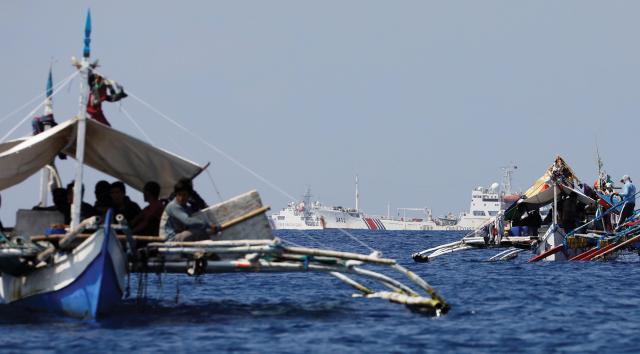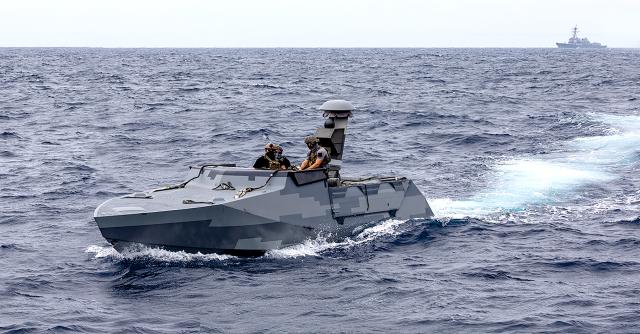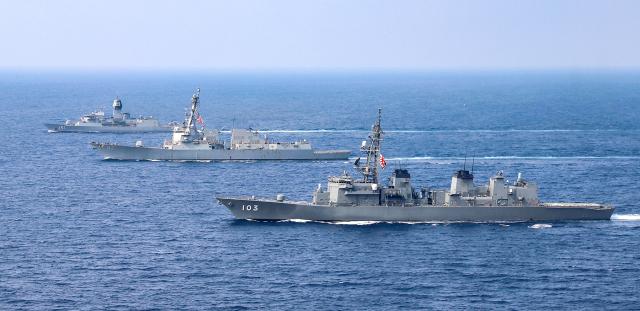James R. Holmes
Director and actor Woody Allen famously joked, “Eighty percent of success is showing up.” Admiral J. C. Wylie, the author of Military Strategy: A General Theory of Power Control, opined that to control something, an armed force must stage firepower on the scene sufficient to control that thing.1 Implicit in Wylie’s analysis is that if you want to control something forever, you may need to remain there forever. Combine the insights from this odd couple, and it seems that 80 percent of martial affairs is showing up and the remaining 20 percent is staying in force.
This oversimplifies matters, but it is sage counsel, nonetheless. Contenders must bestride the field of competition—and stay on the field as long as the contest lasts—to entertain any hope of success. Yet militaries have flouted this simple but profound axiom throughout history. Beguiled by offense, they take territory only to move on—and relinquish control back to the foe, who promptly reoccupies the ground and resumes his own agenda. Intermittent control is no control at all in strategic terms.
Come-and-go offensive operations have a mixed record at best, yet they seem graven on U.S. military culture. American warriors regard garrison duty as static and inglorious, whereas closing with and engaging the foe’s main forces appears rewarding by contrast. During the Vietnam War, for example, top commanders quashed the U.S. Marine Corps’ Combined Action Platoons, a defensive initiative that stationed small bodies of troops in South Vietnamese villages to deny Vietcong insurgents what they desperately needed—control of civilian populations and their key resources. Instead, U.S. ground forces pursued offensive—but often fruitless—search-and-destroy operations in the backcountry.2
Search-and-destroy is not an option in the South China Sea, where China has mounted a gray-zone challenge to the international legal order of the sea. Gray-zone strategies are designed precisely not to escalate to open combat. Defeating them demands a more defensive and more static approach. So, U.S. naval forces must set aside their distaste for defense, much as they set it aside to conduct convoy operations during the world wars, when they stayed close to what needed to be defended. They must go to contested waters and stay, in company with allies and partners, for the duration of the competition.
Want to compete? You have to be there.

The China Coast Guard plays a major role in Beijing’s strategy to cow other nations’ civilian mariners. Here, several China Coast Guard ships patrol near Philippine fishing vessels at Scarborough Shoal—territory that is well within the Philippines’ exclusive economic zone and hundreds of miles away from China’s. Credit: Reuters (Eric de Castro)
Nature of the Challenge
Let’s start by surveying the Chinese challenge. China’s political aim is to abolish the settled legal principle that no one owns the sea, and to replace it with the principle that China can own bodies of water it claims. Beijing has repeatedly proclaimed “indisputable sovereignty”—state ownership—over the vast bulk of the South China Sea.3 Chinese leaders claim this expansive patch of water as “blue national soil,” the equivalent to land, as the phrase suggests.4 The sovereign over a parcel of territory makes the laws dictating what happens there. If the Chinese Communist Party (CCP) gets its way, in other words, it will make the rules in the South China Sea and other expanses Beijing might claim. Others will obey. Freedom of the sea will be no more in those expanses. Neighboring states will lose their rights to harvest natural resources from the offshore exclusive economic zones apportioned to them by the U.N. Convention on the Law of the Sea (UNCLOS).
This is a political aim of breathtaking sweep, and it is precious to China—meaning Beijing is prepared to spend lavishly to obtain it, and to keep up the expenditure as long as it takes. Chinese President and CCP General Secretary Xi Jinping has connected maritime claims to the “Chinese Dream,” his project of national renewal following a “century of humiliation” at the hands of seaborne empires.5 It is hard to see how he could climb down from his vow to make China great again lest he look weak and feckless in the eyes of ordinary Chinese citizens. That is a hazardous prospect for any authoritarian ruler.
A weird, inverted dynamic typifies the U.S.-China contest for freedom of the sea: The challenger is trying to subvert the system from within, while the guardian of maritime freedom stands formally outside the system. U.S. presidential administrations have long declared that they accept UNCLOS as customary international law and thus binding. Yet the U.S. Senate has never consented to the convention, and it remains unratified. Customary law—the practice of states—is a valid source of international law. Yet appeals to custom seldom resonate with international audiences the way a signature on a treaty does. The concept seems abstract and legalistic and requires too much explanation. This cedes advantage in framing the competition to Beijing, which is a signatory to UNCLOS but does not abide by it.
China’s strategy is grounded in the Maoist tradition of insurgent warfare, resulting in a form of “people’s war at sea.” The ruling State Council reaffirmed this Maoist heritage in 2015 when it published a document outlining “China’s Military Strategy.”6 This has three crucial implications for the struggle for nautical freedom. One, insurgent warfare is protracted warfare. No one should expect a quick victory. Two, Beijing relies on irregular means and methods to get its way. Rather than bully Southeast Asian states with the big stick of conventional military force, it harnesses a host of paramilitary or nonmilitary implements—the coast guard, a maritime militia embedded in the fishing fleet, and merchant shipping—as its tools of choice.7 Beijing backs them up with regular forces from the People’s Liberation Army (PLA) Navy, Air Force, and Rocket Force—putting rival claimants on notice that China will prevail should an encounter come to blows.
And three, in operational terms, China is staging what Wylie called a “cumulative” campaign that refrains from “sequential” operations characteristic of open warfare.8 In other words, rather than repeatedly hammer away at foes with massed forces until they can no longer resist, Chinese commanders spread the field. They strive to win lots of small-scale tactical confrontations, dispersed in time and geographic space. Many minor results, they hope, will add up to something major over time.
In practice, China now acts as though it is already the sovereign in disputed waters where it asserts control. Chinese commercial craft fan out across the sea to reap natural riches from it, and law-enforcement ships act as their protector should a coastal state try to defend its prerogatives under the internationally recognized law of the sea. Meanwhile heavy PLA forces remain on call over the horizon, amplifying the coercive and deterrent element of China’s gray-zone strategy while minimizing the appearance of bullying.
In short, China hopes to win without escalating to actual use of arms. This implies a drawn-out competition in which China mounts a show of overpowering force at many hotspots on the nautical chart. If all goes well, outgunned Southeast Asian navies or coast guards will be disheartened by fearful odds. Their governments will stand down, leaving China in possession of disputed seas and closer to its goal of maritime sovereignty.

Countering China’s maritime insurgency will require a mix of U.S. naval and Coast Guard forces that can team with regional partners. During an exercise in February 2022, a Naval Special Warfare combatant craft operated with the USS Ralph Johnson (DDG-114) in the South China Sea. Credit: Naval Special Warfare Group 1 (Matthew Duncker)
U.S. Counterstrategy: The Man on the Scene with a Gun
The U.S. political aim in the South China Sea is simple: to keep this from happening. Washington wants to uphold the status quo founded on the law of the sea. Its posture is strategically defensive. That does not mean the United States must remain passive, awaiting and trying to block Chinese competitive moves after they happen. Washington should grasp the initiative whenever possible.
How? Knitting together a cohesive coalition is imperative. The U.S. strategic position in Southeast Asia is tenuous, founded mainly on modest forces stationed in Singapore, to the South China Sea’s extreme southwest, and heavy forces in Japan, hundreds of miles to the north. In other words, U.S. forces operate from harbors far from potential battlegrounds, which lie chiefly between the Philippines and Vietnam. To improve its strategic positioning for a protracted struggle, U.S. naval forces need reliable staging bases around the South China Sea rim to speed up the response to Chinese aggression. A return to Philippine bases vacated three decades ago would be a welcome development, as would regular access to Vietnamese seaports.
To counter China’s cumulative strategy, U.S., allied, and partner naval forces must not just show up at hotspots but stay, making the point that China would not necessarily prevail should battle erupt. A constant, imposing presence near scenes of impact would compel China to choose between escalating to violent force (something CCP leaders ardently do not want to do) and deescalating to something resembling peacetime diplomacy (and thus postponing its challenge). Though indecisive, inducing Beijing to repeatedly postpone the attempt to consummate its sovereignty claims may be the best Washington can hope to accomplish.
Admiral Wylie would tender two bits of advice. First, he would remind U.S. commanders and their political masters that cumulative campaigns are seldom decisive by themselves. Neither China nor its opponents are likely to secure a speedy victory through scattershot confrontations. Second, Wylie would advise that “the ultimate determinant in war is the man on the scene with the gun. This man is the final power in war. He is control. He determines who wins.” (Emphasis in original.) Wylie continues: “If the strategist is forced to strive for final and ultimate control, he must establish, or must present as an inevitable prospect, a man on the scene with a gun. This is the soldier.” The soldier must be on the scene to take control, or “he must be potentially available, and clearly seen as potentially available, for use as the ultimate arbiter.”9

Allies and partners will be key to showing China the limits of its extortionary measures. In March 2022, the Japan Maritime Self-Defense Force ship Yudachi, the USS Momsen (DDG-92), and the Royal Australian Navy frigate HMAS Arunta conducted a trilateral exercise in the South China Sea. Credit: U.S. Navy/Ctf-71 (Lily Gebauer)
Once again, you have to be there. You have to come toting superior firepower. And you have to stay as long as it takes.
This advice applies not just to soldiers on dry ground, and not just to wartime. It applies to peacetime strategic competition in the maritime domain as well. You must be on scene to control something. Or you have to leave no doubt in the minds of important audiences—the antagonist, as well as your allies and partners—that you will inevitably show up to take control should the antagonist buck your will. Today, China is always on the scene in the South China Sea, and it backs its coast guard and maritime militia with lavish firepower from the regular military. Southeast Asian partners are woefully outmatched. If powerful outsiders are not there to compete with China, they risk surrendering critical real estate to China, and freedom of the sea along with it.
Peacetime competition unfolds not by fighting to a verdict of arms, but by trying to sway the minds of audiences able to make a difference in the competition’s outcome. Competitors display arms to make statements about relative power and weakness. Since battle by definition does not happen in peacetime, whoever most observers think would win in wartime “wins” a peacetime confrontation. Strategic competition is literally a war for perceptions. This is a point Edward Luttwak makes in his book The Political Uses of Sea Power. He calls the process of using military implements to mold perceptions “naval suasion” or “armed suasion.”10
If U.S. naval leaders think about fleet movements as levers for political persuasion and dissuasion, they will design deployments to cast what Luttwak calls a “shadow” across Beijing’s decision calculus.11 That is, they will compel CCP chieftains to factor what nearby U.S. sea and air forces might do into every decision they make. If Chinese leaders see U.S. assets on the scene all the time, or if they are convinced U.S. forces would show up on the scene without fail, brandishing enough combat power to win a fight—or balk China’s efforts to win—they should be deterred.
Luttwak notes that in its 19th-century heyday, the Royal Navy mastered the art of turning token shows of naval force to maximum political effect. Even a single, symbolic frigate might have the desired political effect on a foreign target audience—but again, only if that audience knew full well that a dominant British fleet would show up to impose London’s will by force if needed.12 The Royal Navy left no doubt.
But let’s not kid ourselves. It is doubtful that China and other Asian audiences repose enough confidence in U.S. maritime might for the U.S. Navy, Marine Corps, and affiliated joint forces to get by with a token or virtual presence. In fact, Beijing has geared its entire antiaccess strategy to making sure the U.S. military can’t arrive on the scene, flourishing big guns, in time to impose Washington’s will. As the old joke goes, virtual presence is actual absence. You have to be there to face down an opponent, reassure an ally, and control what matters to you.
There’s a reciprocal point about naval suasion that Luttwak doesn’t make, but it is a logical extension of his analysis. Just as savvy naval overseers use fleet movements, exercises, and so forth to cast a deterrent shadow across councils in hostile capitals—the deeper and darker the better—they can also use those deployments to shine an encouraging beacon on allies, friends, and partners. Washington can give partners heart by persuading them the U.S. military has the combat prowess and the resolve to keep its commitments to them—and to prevail should a dispute escalate into a trial of arms. If they have confidence in America’s military prowess, U.S. alliances will endure. This, too, is central to strategic competition at sea.
So, what is the upshot of all these ideas from history, and from the greats of maritime strategy? The main takeaway is that the U.S. Navy needs to quit coming and going and start going and staying if Pentagon leaders hope to succeed in the gray zone. Freedom-of-navigation operations (FONOPs) make an important legal statement that the United States rejects maritime claims that go beyond what UNCLOS permits, as China’s do, and as the Hague-based Permanent Court of Arbitration confirmed in 2016.13 They are worth doing and must continue. But they are not a deterrent to gray-zone aggression in any meaningful way. All they prove is that U.S. ships can show up, drive through contested waters, and go away. They are not “control” in Wylie’s sense. Like search-and-destroy operations in Vietnam, FONOPs are impressive but transient. They cast a faint shadow across Beijing while reassuring few Asian partners that the United States will be there for them in times of extreme peril.
Wylie and Luttwak would disapprove.
Occasional carrier-strike-group or surface-action-group operations are better in that they involve serious battle forces. But such operations are sporadic and do not last long. Now, if a carrier strike group or some other hard-hitting formation were based in the South China Sea or Australia, closer to likely scenes of action, that might cast Luttwak’s shadow or sunbeam on audiences Washington needs to influence. U.S. commanders should look through the eyes of a Philippine or Vietnamese fisherman, and design operations to give that person solace as he plies his trade in the face of Chinese attempts to coerce and intimidate him and impoverish his family. A standing presence reminiscent of the Royal Navy’s, with light forces on the scene and heavy forces available over the horizon to provide backup, would be a testament in steel to U.S. power and resolve either to be on the scene with potent firepower or to get there quickly and stay. Beijing could not overlook such a presence.
The challenge before Washington and its partners today is to determine how to exert control of key seas, cow a powerful, resolute antagonist, and gladden the hearts of friends and allies. An ironclad principle to guide their efforts should be: Station a man on the scene with a gun.
No comments:
Post a Comment